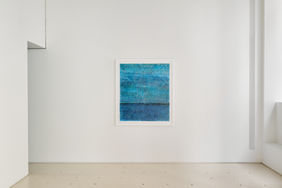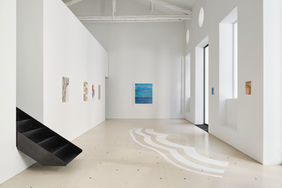•
Unframing Views
Oliviero Fiorenzi
Gabriella Hirst
Elena Mazzi
Marzena Nowak
Giacomo Segantin
19th September - 07th November 2025

Artopia is pleased to inaugurate the new exhibition season 2025-2026 on Thursday 18 September with the exhibition Unframing Views, featuring five artists: Oliviero Fiorenzi (Osimo, 1992), Gabriella Hirst (Sydney/Cammeraygal, 1990), Elena Mazzi (Reggio Emilia, 1984), Marzena Nowak (Piaseczno, 1977) and Giacomo Segantin (Abano Terme, 1995). The works on display, ranging from site-specific installations to works on paper and video, intertwine in a multifaceted dialogue aimed at deconstructing and reconstructing the formal language linked to landscape and its representation.
The exhibition project adopts the geographical concept of map, a graphic representation commonly used to delineate a defined context and offer an objective depiction, and trasforms it into a tool for understanding complex realities that go beyond a neutral observation. The artists turn this element into a personal narrative device that questions whether what happens outside is actually a reflection of inner actions and processes. The view of the landscape, the connection with space and the influence it has on psychological and emotional dynamics, themes that have always characterised the gallery’s conceptual research, take shape in a variety of media and interpretations throughout the two open floors of the gallery.
The large floor installation Dima per evaporazione (2025) by Giacomo Segantin welcomes visitors. Paper shapes on a 1:1 scale reconstruct the limestone stains of the monumental disused fountains observed by the artist in the Bicocca district of Milan, visible above thanks to satellite mapping. They represent a trace, a sort of contemporary archaeology that invites reflection on the specific identity that characterises an urban neighbourhood. On the wall behind, Elena Mazzi’s Polar Silk Road map series (2025) recounts the geopolitical transformations of the Arctic, exploring the relationship between climate change and landscape transformation and how we look and relate to it. In a combination of printed paper and pictorial intervention, Oliviero Fiorenzi develops a personal hydrographic map that intertwines natural and emotional geography. The artist reconstructs a poetic cartography, where the water cycle – rain, rivers, sea, evaporation,
clouds – is reflected in an inner cycle, made up of emotions that flow and shape the body. The video room hosts Gabriella Hirst’s video Force Majeure (2016), which depicts the artist attempting to paint a seascape in adverse weather conditions. The work questions the buffer zone needed between an event and its representation, as well as the arrogance of the Romantic painting tradition that seeks to capture vast phenomena within a small rectangular frame.
In an intimate and delicate narrative, Marzena Nowak’s drawings give shape to the ephemeral and volatile matter of memory, through lines that blur the boundary between dream and reality. The artist seeks to map her memories, engaging in a poetic and perceptive transformation in which past experiences are combined with projections and interpretations of the present, starting from fragmented impressions, details and gestures of everyday life.
Unframing Views transforms the exhibition space into an active container capable of evoking dialogue and imagination. By subverting a canonical point of view of measurement, the exhibition offers new ways of observing and interacting with the space around us and opens an exhibition programme aimed at emphasising Artopia’s connection with architecture and landscape.

• Photos by Michela Pedranti
Oliviero Fiorenzi
Oliviero Fiorenzi (Osimo, 1992) is a visual artist who lives and works in Milan. His research explores the interaction between wind, landscape and community through kinetic devices and installations activated by the movement of air, a symbol of connection and renewal. His practice, often collective and performative, focuses on public participation and context. He has exhibited in institutional and independent spaces including the Italian Pavilion at Expo Osaka 2025 (Osaka, Japan), Fondazione Feltrinelli and Triennale Milano (Milan), Manifattura Tabacchi (Florence), Ex-Dogana (Rome), La Mole (Ancona), The Address (Brescia) and Sonnenstube (Lugano). He has also collaborated with Dynamo Camp and Ca’ Foscari University in Venice and participated at Pesaro 2024 – Italian Capital of Culture.
Gabriella Hirst
Gabriella Hirst (Australia / Germany) is an artist and writer whose practice spans moving image, performance, installation, and the garden as a site of critique and
care. Her work explores tensions between acts of care and control, and how the surfaces of systems of power are produced and maintained. Recent projects examine the connections between plant taxonomies, landscape painting, art conservation and nuclear history. Her works have been shown, commissioned and performed recently at The Nicoletta Fiorucci Foundation (UK), Flag Foundation (NYC), The Sainsbury Center (UK), ACMI (AU), AGNSW (AU), Kunsthalle Osnabruck (DE). Recent awards/residencies include The Delfina Foundation (2025), Villa Romana (2024) and the ACMI/Ian Potter Moving Image Commission (2020). From 2020-2023 she was an associate lecturer in the RCA School of Architecture, leading the media studies section “Practices of Care and Control”.
Elena Mazzi
Elena Mazzi (Reggio Emilia, 1984), studied at the University of Siena and the IUAV in Venice, after which she trained at the Royal Institute of Art (Konsthögskolan) in Stockholm. Starting from the examination of specific territories, in her works, she reinterprets the cultural and natural heritage of places, interweaving stories, facts and fantasies handed down by local communities, in order to suggest possible resolutions to the man-nature-culture conflict. Her somewhat anthropological working method favours a holistic approach aimed at repairing the rifts that occur in society. She begins the work with observation and proceeds by combining various areas of knowledge. Her works have been exhibited in solo and group exhibitions, including: Lulea Biennale, PAV – Parco Arte Vivente in Turin, der TANK in Basel, BIENALSUR, MADRE in Naples, ar/ge kunst in Bozen, Sodertalje Konsthall in Stockholm, Whitechapel Gallery in London, BOZAR in Brussels, Museo del Novecento in Florence, MAGA in Gallarate, GAMeC in Bergamo, MAMbo in Bologna, AlbumArte in Rome, Sonje Art Center in Seoul, Palazzo Fortuny in Venice, the Golinelli Foundation in Bologna, 16th Quadriennale in Rome, GAM in Turin, the 14th Istanbul Biennial, the 17th BJCEM Mediterranean Biennial, COP17 in Durban, the Italian Cultural Institute in New York, Brussels, Stockholm, Johannesburg and Cape Town, and the Bevilacqua La Masa Foundation in Venice. She is the winner of Cantica21 promoted by the Foreign Ministry and the Ministry of Culture, of the 7th and 12th edition of the Italian Council sponsored by the Ministry of Culture. Elena Mazzi is presently undergoing a practice based PHD at Villa Arson in Nice.
Marzena Nowak
Marzena Nowak (Piaseczno, 1977), lives and works in Thouars. Her artistic research focuses mainly on the relationship between memory and imagination, between autobiography and the dream world. Nowak’s work, to be contextualized in the historical-social context of the political changes of the 80s, plays with the forms of sensory perception and the intertwining between the tasks of everyday life and the desire to take refuge in fantasy. She has exhibited in numerous international museums including: COCA Center of Contemporary Art, Torun (2011); Salzburger Kunstverein, Salzburg (2011); Künstlerhaus, Salzburg (2011); MUMOK - Museum Moderner Kunst, Wien (2012)Warsaw Museum of Modern Art; Warsaw (2014); CAC - Contemporary Art Center, Vilnius (2015); Pori Art Museum, Pori (2016); Neuer Kunstverein, Wien (2018); Stiftung Ludwig, Wien (2021).
Giacomo Segantin
Giacomo Segantin (Abano Terme, 1995) lives and works between Milano and Colli Euganei. He studied at the Academy of Fine Arts in Verona and attended the two-year course in Visual Arts and Curatorial Studies at NABA, Milan. His practice tends to deconstruct stereotypes related to landscape and territorial identity, proposing a vision of a complex reality, in constant movement. He has taken part in several residencies and research projects including Mustarinda, Hyrynsalmi, Finland (2023); Uncivilized Paradigms, promoted by BJCEM, curated by Alessandro Castiglioni and Simone Frangi; progettoborca, Borca di Cadore, Dolomiti Contemporanee (2020), Fondazione Bevilacqua La Masa, Venice (2019). His work has been included in several exhibition projects such as We are the flood, curated by Stefano Cagol, Spazio Archeologico Sotterraneo, Trento (2022); Cantica21, production award supported by MAECI and MiC, Canada (2021); To see, to know, to play, curated by Eleonora Reffo, Villa Borromeo, Fontaniva (2020); 51zero, International Moving Image and Contemporary Art Festival, Rochester/Canterbury, UK (2019). In 2024 his work becomes part of the collection of the MuSe Museo delle Scienze in Trento thanks to the PAC (Contemporary Art Plan, 2023 edition).

















